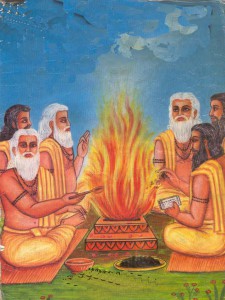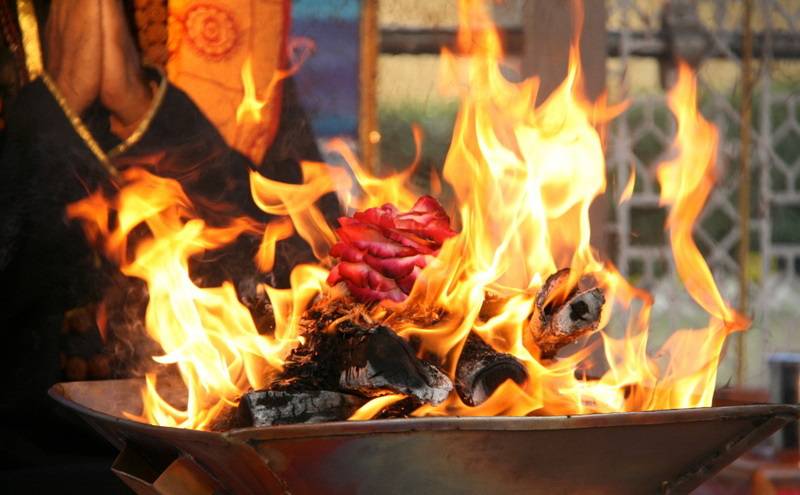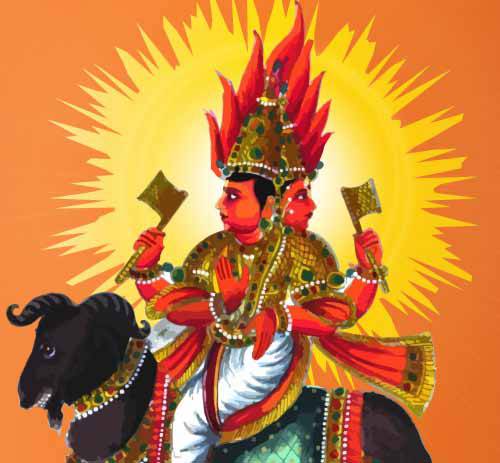No products in the cart.
Agni is an ancient Hindu deity who is one of the most important Vedic gods. Agni is the god of fire, the messenger of gods, and accepts sacrifices made to him from anyone who is devoted to his Lord. He was very important to the people living in the Vedic times, and they have 200 hymns addressed to him in the Rig Veda. Eight of the ten books begin with praises for Agni, the god of fire.
Agni is present in everyone’s hearth. He is supposed to be the vital spark of life, and the food in people’s stomach is burned by Agni. Agni is also the fire of the Sun, and gives it brilliance and heat that the Sun is known for. Agni is very essential for the survival and development of humans, which is why people have been praying to him since ancient times.
Agni is sometimes said to be the twin brother of Lord Indra, the ruler of the heavens, and is often closely associated with him. In Vedic times, he occupied the most important position after Indra. Along with Indra and Surya, he makes up the holy triad of Vedic gods.
Iconography of Agni
He is depicted as having two heads. One head signifies immortality, and the other is a symbol of life. He was one of the Supreme gods of the early Vedic period, along with Indra and Varuna. He is often said to be the link between the heaven and earth, and humans and deities. He is associated with Vedic sacrifice, and takes sacrifices of the devotees to their beloved and much respected and adored gods in his fire.
His mount, or ram, is said to be the ram. The people living in the early Vedic period, who developed the worship of fire, personified him as the sacrificial fire. It is said that Agni was born in three levels, earth, mid-space, and heaven. It reflects the ‘domestic fire’, the ‘defensive fire’ and the ‘’offering fire’ in a Vedic household.
Once Agni had offended sage Bhrigu, who cursed him to become the devourer of everything in this world. Terrified of this curse, Agni went to Brahma and requested him to do something about it, otherwise Agni would have been responsible for the destruction of the entire world. So, Brahma modified the curse in such a way that Agni became the purifier of all the things he touched.
The Birth of Agni
The origin of his birth is a mystery. Different people have different ideas about it. Some say his parents were sage Kashyapa and Aditi, some say he was born of Dyaus Pita and Prithvi, and some say he was the son of a queen who kept his birth a secret from her husband, the king. Agni is sometimes said to be the son of ten mothers, who were all sisters, depicting the ten fingers of a man. His sisters are the personification of night and dawn, and his wife is Svaha. He is the father of Pavak, Pavman, and Suchi. He has been given various names over the years, like Jivalana, Dhananjaya, and Vahni.
When Agni is represented in a humanoid form, he is shown to have two faces, which are smeared with butter, to provide fuel to the flame. He has seven fiery tongues and sharp golden teeth. He has black, long hair, and is red in colour. Seven rays of light come out of his body, and he has seven hands and three legs. He is often shown to be riding a chariot either pulled by rams or goats, or sometimes he rides parrots.
Agni does not differentiate between his devotees, and visits everyone’s hearth irrespective of their financial status. For him, the young and the old, the rich and the poor, a Brahmin and a Kshatriya, everyone is equal. He is often thought to be a mediator between the heaven and earth, which is why all yajnas take place with Agni being present.

It is said, that when people use fire, they should use it in different directions. For using fire to offer sacrifices to the gods, the fire should be in the direction facing east. When facing south, the fire should be used to offer sacrifices to the dead. When using fire for cooking food, the direction should be in the direction of west. Agni also has the power to reduce a person’s sins after his death, or grant him immortality.
In the later Vedic period, his prominence reduced considerably. He was shown as an incarnation of either Shiva or Brahma, and eventually was called on by men who wanted to increase their virility. Agnicayana and Agnihotra are the Vedic rituals used with Agni.
Agni is also one of the guardians of directions. He is said to be the guardian of the south east direction. He gives out the light of knowledge and leads us to the path of truth. He is the mouth of the gods, as he’s the divine personification of the sacrificial fire.
In Hari Vans, Agni is dressed in black and has smoke all around him. He is shown to have four hands, and drives a chariot with four red horses. The Agni Purana is said to have been recited to sage Vashishta by Agni himself. He is the innermost light who gives brightness to all animate and inanimate objects.
The Ten Forms of Agni
Agni is said to have ten forms. They are lightning, fire, sun, absorbing fire, destructive fire, fire yielded through sticks used for sacrifices and rituals, fire given to a student during his Upanayana ceremony, domestic fire used for household uses, southern fire of ancestors used for some types of rituals and funeral fire in cremation rituals.
In the Hindu scriptures, Agni is mentioned to be present at all times during the birth of a person (diya lamp), prayers (diya lamp), at weddings, when the bride and groom circle the sacred fire seven times, and at death, when a person is burned at the cremation ground.
Agni – One of the 3 Prominent Deities During Vedic Period
In the Vedas, it is written that Agni, Vayu and Soma are the representation of Fire, Water and Air. These are three of the five tanmantras born from the three heated worlds. They were the principal deities in the Vedic times. Agni used to bring the subject and the object together and establish a relationship between them, known as sambandha. Vayu helped in the progress and development of that relationship, known as abhidheya. Soma used to convert forms into pleasure felt in the consciousness, known as prayojna.
A lot of animal sacrifices were also made to Agni during the Vedic times. Agni was said to be the representation of all the others gods, so anyone who wished to pray to any god had to use Agni for that. The animals to be sacrificed were often tied to an octagonal wooden stake called yupa. During an ashwamedha ceremony, animals were often sacrificed to Soma or Prajapati.
The Agni Purana, which is eight among the eighteen Puranas, states that one cannot approach any god without using Agni as a medium. No divinity can come without the presence of Agni. It is also written that Agni was the son of Agniras, who discovered fire and its uses. His most destructive form is the Kravyad form.
Agni has had three births. His first birth was in the heavens, when he appeared as a bolt of lightning. He took his second birth among humans as Jataveda, and his third birth took place in water.
Jataveda is the form used to carry the offerings to gods by people performing yajnas. It is identified with everything pious and knowledgeable. Kravyad is the form used to burn the corpses of humans or animals after their death in the Pitri-yajna, and Agni is obtained from the rays of the sun for this purpose.
Agni is the messengers who carries all the prayers and wishes of devotees to the gods. When Agni is happy, the gods are generous and listening to the prayers of the people. Together with Soma, Agni is invoked the most in the Rig Veda among all the gods. The cultivated, cooked and cultured aspects of Vedic ritual are represented by Agni.
According to the Vayu Purana, the three sons of Agni stand for his three forms. Pavaka represents the electric fire, Pavamana represents the fire produced by friction, and Suchi is the fire of the sun. They are said to have been cursed by sage Vashishta, and take births again and again in this world.
Being one of the most important gods right since the Vedic times, Agni is ever important for humans even now, and it would be very difficult for life on earth to sustain and develop with the blessings of Lord Agni, the God of Fire.







